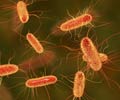Scientists have reported development of the first two-in-one test that can simultaneously detect the E. coli bacteria
Scientists have reported development of the first two-in-one test that can simultaneously detect the E. coli bacteria responsible for terrible food poisoning outbreaks. They described it at the 239th National Meeting of the American Chemical Society (ACS), being held here this week.
The bacteria — a strain called E. coli O157 — may be present in food for hours or days before improper storage conditions allow them to grow and produce the toxins that actually cause food poisoning. Those toxins can remain in food even after the bacteria are dead and gone. In the past, it took separate tests to protect against this double threat from the bacteria and the toxins."Our test may be used in meat processing plants to allow in-house testing of products prior to sale," says project leader John Mark Carter, Ph.D. He is with the U.S. Department of Agriculture's Agricultural Research Service in Albany, Calif. "This would reduce the frequency of foodborne illness, reduce product recalls, and enhance public health while reducing annual cost for food testing."
Food poisoning caused by E. coli O157 sickens more than 70,000 people each year in the United States and causes at least 60 deaths. Although outbreaks have involved foods as diverse as lettuce, spinach, tomatoes, and peanut butter, ground beef remains a major concern. The bacteria may get into ground beef when meat is contaminated with fecal material from chickens or cattle during slaughtering or processing. If the meat is not properly chilled, the bacteria may multiply and produce enough of two main toxins — called Shiga toxin 1 and Shiga toxin 2 — to cause illness.
Until now, there was no two-in-one test for the bacteria and the toxins. Separate tests were required for each threat. Current tests for E. coli in beef also are time-consuming. The results take 3 to 5 days. The new test cuts the waiting time to just 24 hours, the researchers say. The test is slightly less sensitive than current tests, but scientists think the sensitivity can be improved.
The new test uses microscopic plastic beads, each 1/100th the width of a grain of sand, containing a fluorescent dye. The beads, customized in Carter's lab, are coated with antibodies that lock onto proteins or antigens present on E. coli and its two main toxins. During the test, the beads are mixed together with ground beef or other food samples and then separated and run through an instrument. It identifies beads that have latched onto the E. coli antigens.
"Finding a few E. coli bacteria in a large sample of ground beef or other food is like looking for a needle in a haystack," Carter says. "This new method makes the needle much easier to find, compared to standard methods. But improvements in sampling and sensitivity are still needed."
Advertisement
Advertisement
RAS









